Winged figures have been a frequent feature in art from the ancient period to present day, adding a celestial presence to each and every composition. From the sanctity of the Christian archangel Gabriel to the child-like figure of cupid, these heavenly creatures have a wide range of associations.
 Above: a selection of artworks from different eras featuring angels, putti, nike and cupid
Above: a selection of artworks from different eras featuring angels, putti, nike and cupid
Angels grace many of the oil paintings and decorative items that find their way into our conservation studio. This article will look at the origins of different angelic figures across the history of art.
 Above: a detail from The Annunciation by Peter Candid, 1585
Above: a detail from The Annunciation by Peter Candid, 1585
Mythological figures
One of the earliest examples in the evolution of the angel form is the Winged Victory of Samothrace. Believed to be a votive statue of the victory goddess Nike, the draped figure dates to the second century BC, making it an important artefact straight from the Hellenistic era rather than a typical Roman copy of a Greek sculpture.
 Above: three terracotta vases from the 4th century BC featuring the winged figure of Nike
Above: three terracotta vases from the 4th century BC featuring the winged figure of Nike
The winged figure of Eros is one of the most recognisable from ancient history. The son of Aphrodite and Ares (love and war), his Roman counterpart was Cupid. Depictions of Cupid vary from that of a small, mischievous boy to a slender young man. The depictions of Eros or Cupid as a child are usually paired with his mother Aphrodite or Venus. The depictions of Cupid as a young man usually pair him with his wife Psyche and reference their love story.
 Above: a terracotta sculpture of Eros from the 4th century BC, The Marriage of Cupid and Psyche by Andrea Schiavone from 1540, a terrecotta Eros from 200-150 BC, Diana and Cupid by Pompeo Batoni from 1761
Above: a terracotta sculpture of Eros from the 4th century BC, The Marriage of Cupid and Psyche by Andrea Schiavone from 1540, a terrecotta Eros from 200-150 BC, Diana and Cupid by Pompeo Batoni from 1761
Thanatos is another winged figure from Greek mythology. The personification of death, he was a child of Nyx (night) and a brother of Hypnos (sleep). The central themes behind these figures of victory, adoration and death, help us to understand the concepts that would develop into Christian iconography.
 Above: a detail from an engraving of Cupid and Psyche after Giulio Romano, 1573–74
Above: a detail from an engraving of Cupid and Psyche after Giulio Romano, 1573–74
Putti
Putti or Putto are angelic figures found in many genres of art, their role is to add a sense of otherworldly connection and a divine presence. However, they are not confined to religious imagery, many examples are found in mythological paintings or even earthly scenes such as royal portraiture.
 Above: an engraving of Three Putti with Trumpets by Albrecht Dürer from 1500, Jupiter and Callisto by François Boucher from 1763 and a Venetian palace ceiling by Gaspare Diziani from the mid 18th century
Above: an engraving of Three Putti with Trumpets by Albrecht Dürer from 1500, Jupiter and Callisto by François Boucher from 1763 and a Venetian palace ceiling by Gaspare Diziani from the mid 18th century
Putti typically appear as babies or young children, they may include their entire body – with or without wings – or simply a flying head. They most often appear in groups, signalling victory and devotion to the subject matter through the appearance of practising a choral song or playing music. In baroque and rococo art, putto may frame a scene to add drama, holding drapery or floral wreaths.
 Above: a detail from The Last Judgment by Joos van Cleve, 1525–30
Above: a detail from The Last Judgment by Joos van Cleve, 1525–30
There are also examples of putti in their own compositions, reminiscent of cupid in their mischievous antics and child-like innocence. These are often found on ceilings and interior panel work, thus giving the owners of the property the divine connotations usually afforded to painted subjects.
 Above: a group of Putti forming an ‘Allegory of Lyric Poetry’ by François Boucher, 1753
Above: a group of Putti forming an ‘Allegory of Lyric Poetry’ by François Boucher, 1753
Cherubs
Unlike putti, cherubs are a purely religious form of child angel. Referred to as cherubim in the Hebrew texts, these angels were originally described as having a double pair of wings and four faces, including a lion, oxen, human and eagle. Their original function was to act as guardians of the Garden of Eden – making them powerful allies of God, unmoved by human emotion.
 Above: cherubs at the feet of Christ in The Lamentation by Domenichino from 1603, a winged chuerb sculpture from the 18th-19th century, and cherubs above the holy family in The Flight into Egypt by Carlo Maratti, 1664
Above: cherubs at the feet of Christ in The Lamentation by Domenichino from 1603, a winged chuerb sculpture from the 18th-19th century, and cherubs above the holy family in The Flight into Egypt by Carlo Maratti, 1664
In Christian theology, cherubs were ranked as third place in the hierarchy of angels and differentiated by other heavenly beings by their divine knowledge. Their form developed in western art history from ancient visual themes rather than their literal description in the Old Testament. This made what might have otherwise been a fairly alarming creature appear accessible and reasonable to the masses, allowing artists work to be supported by a well-established divine form.
 Above: Saint Rosalie Interceding for the Plague-stricken of Palermo by Anthony van Dyck from 1624, The Immaculate Conception by Guido Reni from 1627 and The Intercession of the Virgin after Rubens from 1610-37
Above: Saint Rosalie Interceding for the Plague-stricken of Palermo by Anthony van Dyck from 1624, The Immaculate Conception by Guido Reni from 1627 and The Intercession of the Virgin after Rubens from 1610-37
Biblical angels
Like cherubim, there are many forms of winged figures in the Old and New Testaments, as well as associated texts from Hebrew and Christian scholars. Some of the most well-known in Christian art are the archangels.
 Above: glazed terracotta relief of Saint Michael the Archangel by Andrea della Robbia, 1475
Above: glazed terracotta relief of Saint Michael the Archangel by Andrea della Robbia, 1475
Archangels are popular in art history due to their connection with two dramatic events – the annunciation and the fall of Lucifer. The annunciation has been composed in many mediums over centuries, with many artists choosing to include the archangel Gabriel alongside Mary.
 Above: The Annunciation by Philippe de Champaigne from 1644 and a gold and silver german plaque from the 15th century
Above: The Annunciation by Philippe de Champaigne from 1644 and a gold and silver german plaque from the 15th century
The fall of Lucifer is the tale of an angel falling from grace to rule hell, the archangel Michael is a central figure in these compositions – often depicted in golden armour and standing over the defeated lucifer in a human or demonic form. In Christian and Jewish texts, Michael is often considered to be the highest ranking archangel, followed by Raphael, Gabriel, Uriel, Sariel, Raguel, and Remiel.
 Above: Saint Michael by Master of Belmonte from 1450-1500, an engraving of Saint Michael after Raphael from 1514-16, Saint Michael Expelling the Fallen Angels from the 16th century and an enragving of The Seven Archangels by Hieronymus Wierix, 1570-1619
Above: Saint Michael by Master of Belmonte from 1450-1500, an engraving of Saint Michael after Raphael from 1514-16, Saint Michael Expelling the Fallen Angels from the 16th century and an enragving of The Seven Archangels by Hieronymus Wierix, 1570-1619
Further angelic forms from biblical sources include the seraphim and ophanim, although these are not often traditional human figures with wings. The seraphim are caretakers of God’s throne in Christian theology, acting as a holy choir who continuously sing in heaven. Seraphim are visually derived from ancient Egyptian iconography and are usually depicted with several wings. One of the most unusual angelic figures is the Ophanim, described as interlocking rings or wheels, covered in all-seeing eyes.
 Above: a detail from Tobias Curing His Father’s Blindness by Bernardo Strozzi from 1630-35, featuring the archangel Raphael
Above: a detail from Tobias Curing His Father’s Blindness by Bernardo Strozzi from 1630-35, featuring the archangel Raphael
How can we help?
We have restored many religious and mythological paintings, from the 16th century through to art deco. If you have a painting or sculpture in mind for restoration, please get in touch today.
 Above: a ceiling mural halfway through conservation by our team
Above: a ceiling mural halfway through conservation by our team
Our conservation team is happy to offer advice and assist you with any artwork concerns. Email via [email protected] or call 0207 112 7576

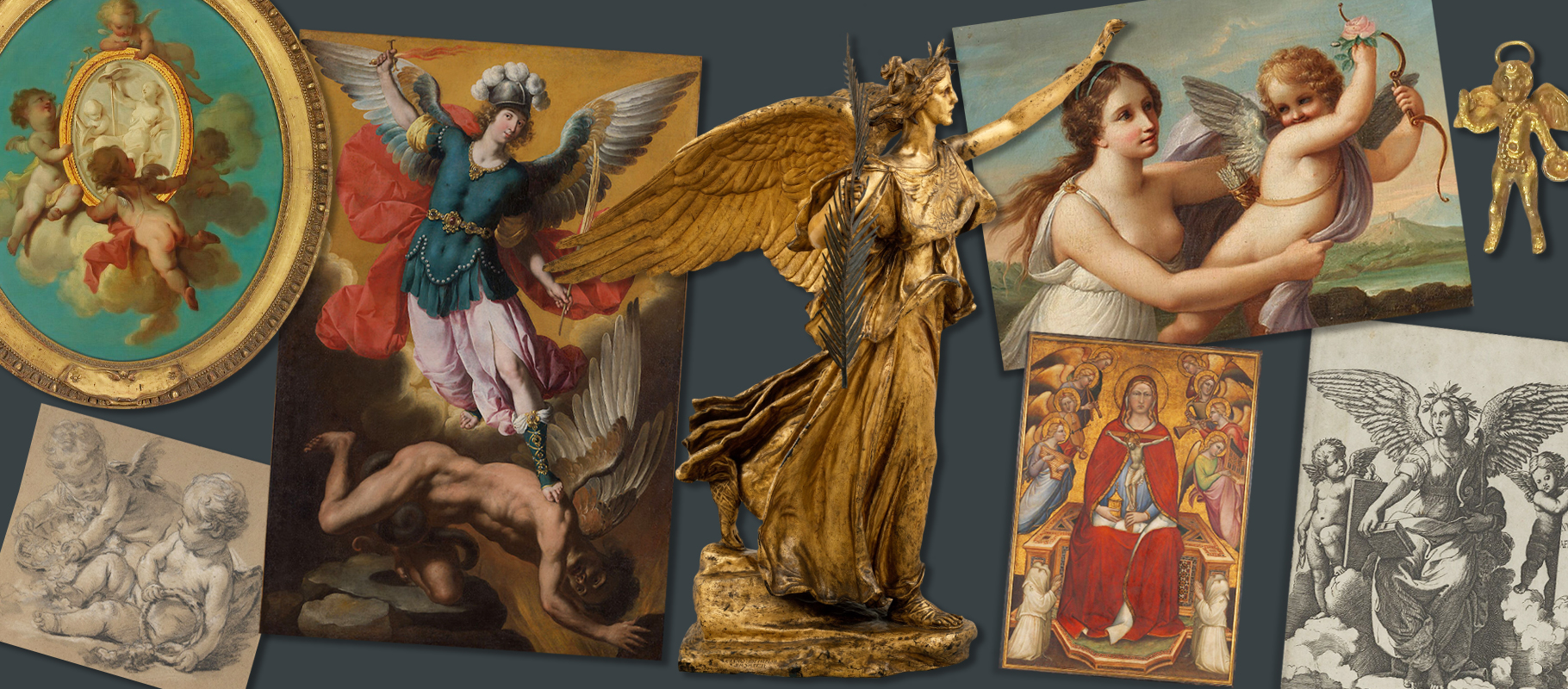 Above: a selection of artworks from different eras featuring angels, putti, nike and cupid
Above: a selection of artworks from different eras featuring angels, putti, nike and cupid 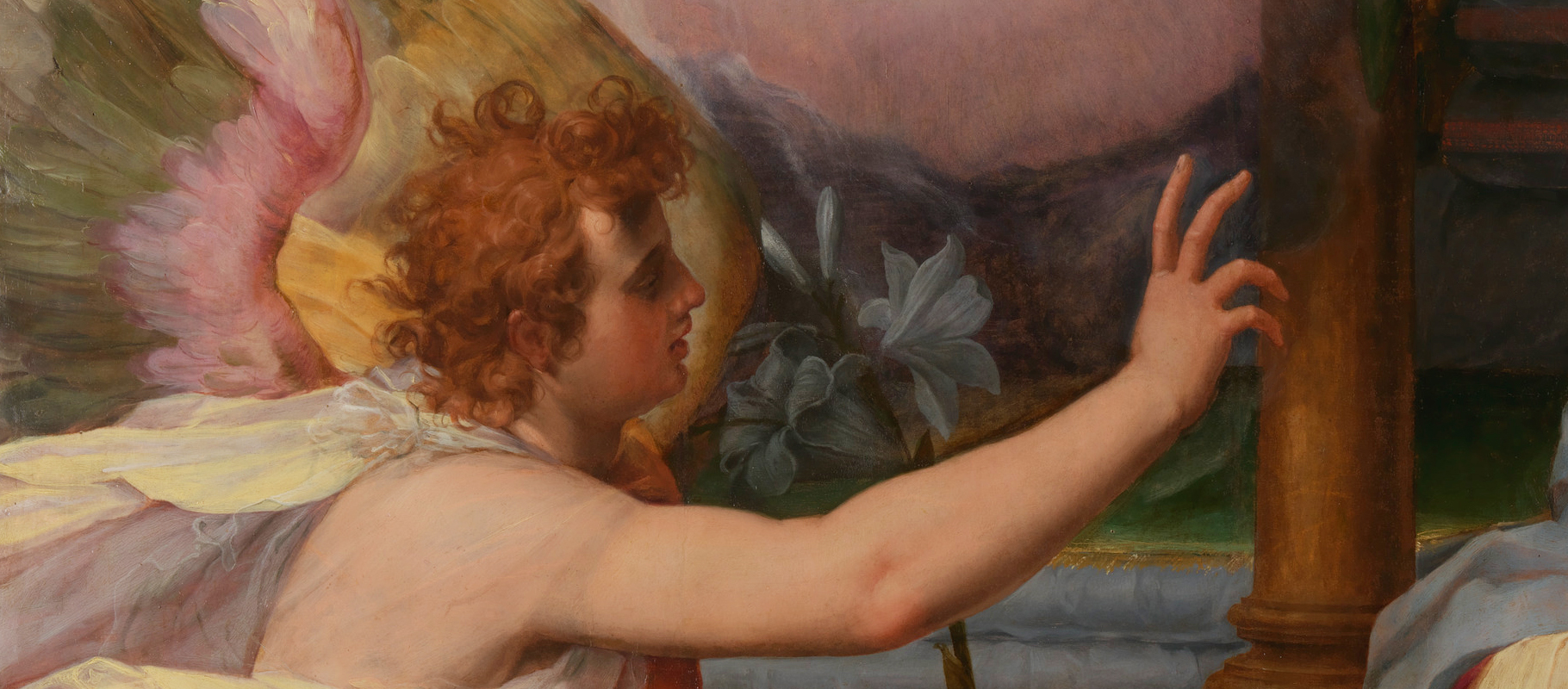 Above: a detail from The Annunciation by Peter Candid, 1585
Above: a detail from The Annunciation by Peter Candid, 1585 Above: three terracotta vases from the 4th century BC featuring the winged figure of Nike
Above: three terracotta vases from the 4th century BC featuring the winged figure of Nike 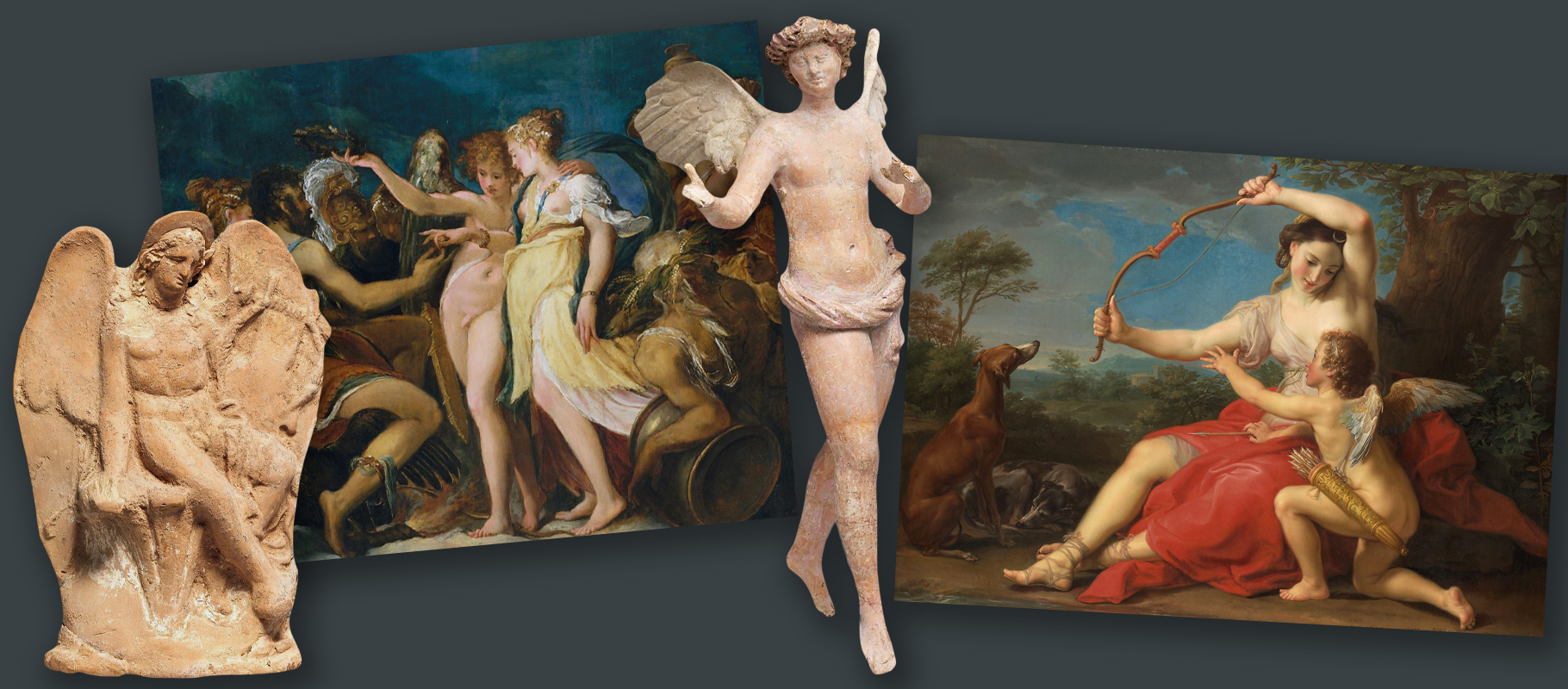 Above: a terracotta sculpture of Eros from the 4th century BC, The Marriage of Cupid and Psyche by Andrea Schiavone from 1540, a terrecotta Eros from 200-150 BC, Diana and Cupid by Pompeo Batoni from 1761
Above: a terracotta sculpture of Eros from the 4th century BC, The Marriage of Cupid and Psyche by Andrea Schiavone from 1540, a terrecotta Eros from 200-150 BC, Diana and Cupid by Pompeo Batoni from 1761 Above: a detail from an engraving of Cupid and Psyche after Giulio Romano, 1573–74
Above: a detail from an engraving of Cupid and Psyche after Giulio Romano, 1573–74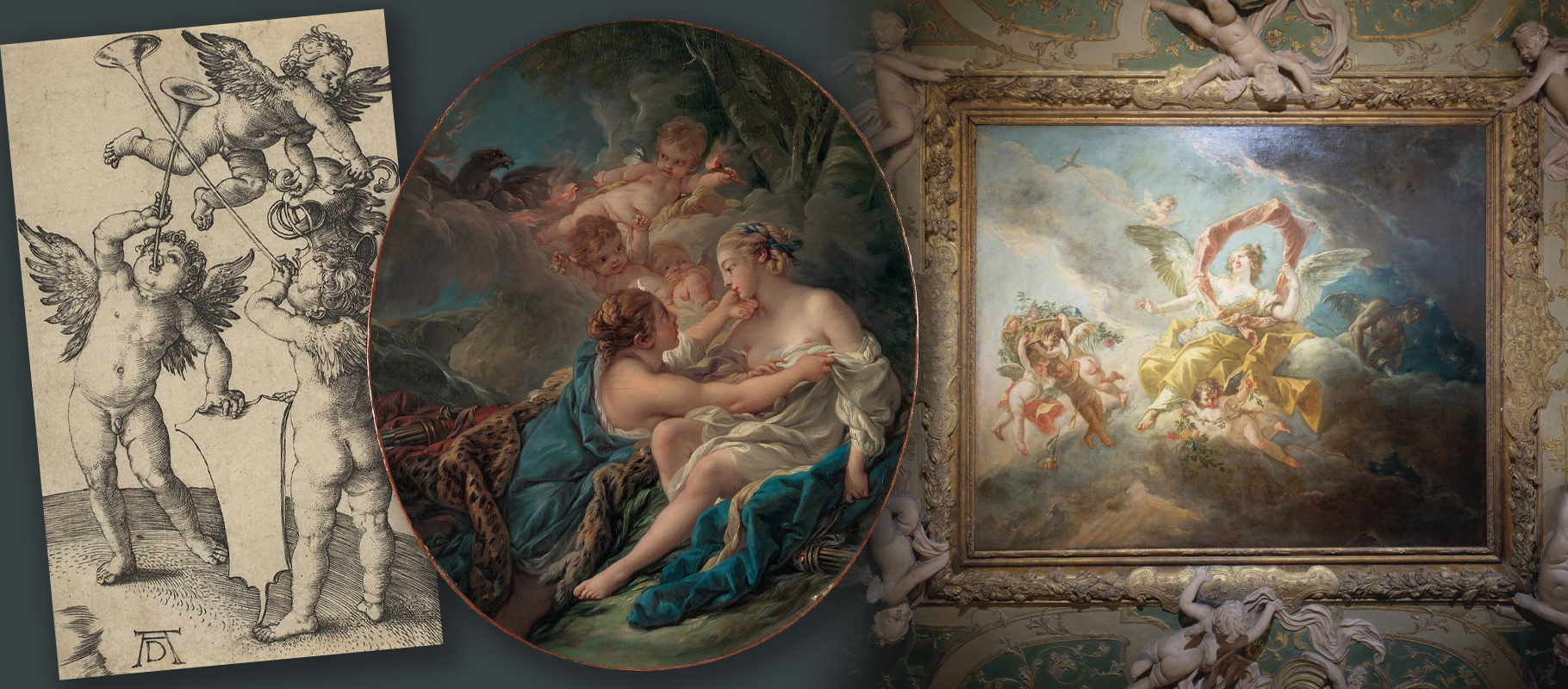 Above: an engraving of Three Putti with Trumpets by Albrecht Dürer from 1500, Jupiter and Callisto by François Boucher from 1763 and a Venetian palace ceiling by Gaspare Diziani from the mid 18th century
Above: an engraving of Three Putti with Trumpets by Albrecht Dürer from 1500, Jupiter and Callisto by François Boucher from 1763 and a Venetian palace ceiling by Gaspare Diziani from the mid 18th century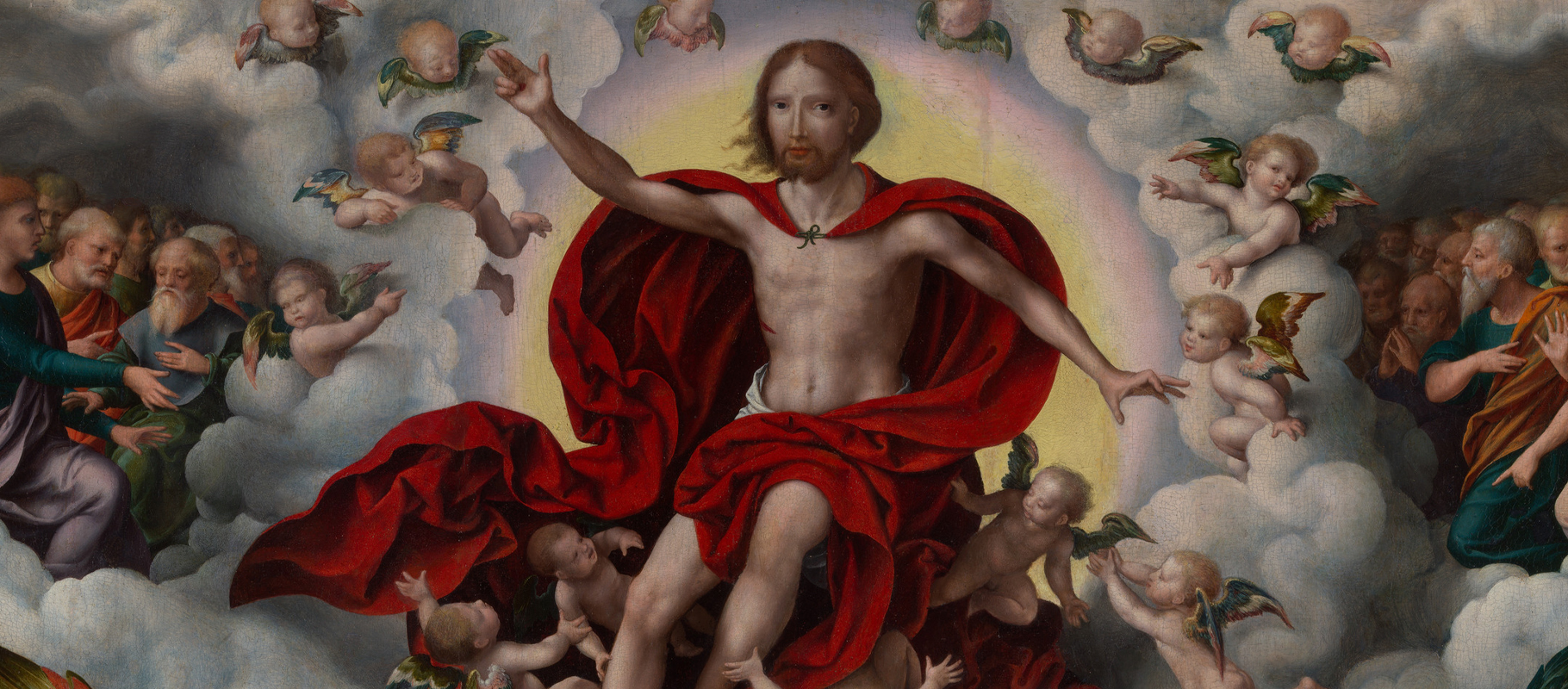 Above: a detail from The Last Judgment by Joos van Cleve, 1525–30
Above: a detail from The Last Judgment by Joos van Cleve, 1525–30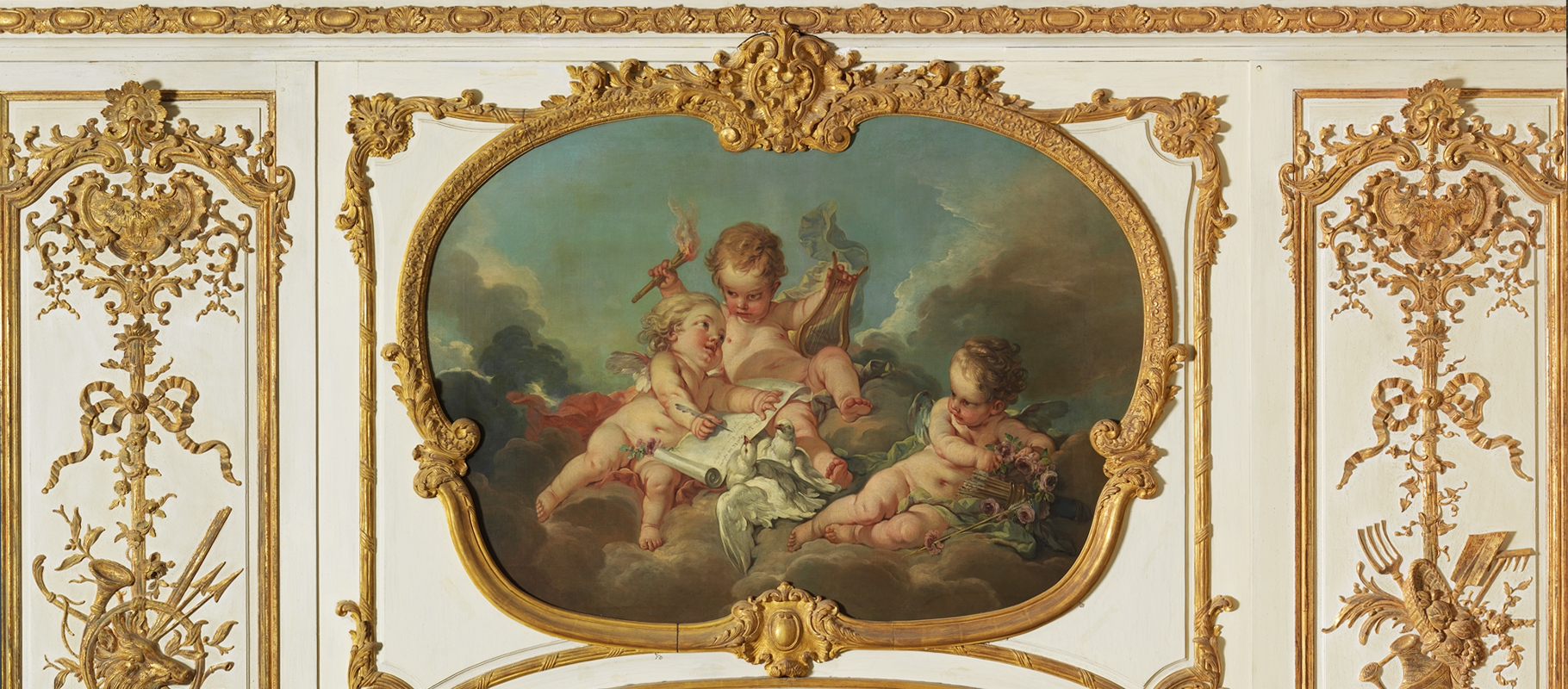 Above: a group of Putti forming an ‘Allegory of Lyric Poetry’ by François Boucher, 1753
Above: a group of Putti forming an ‘Allegory of Lyric Poetry’ by François Boucher, 1753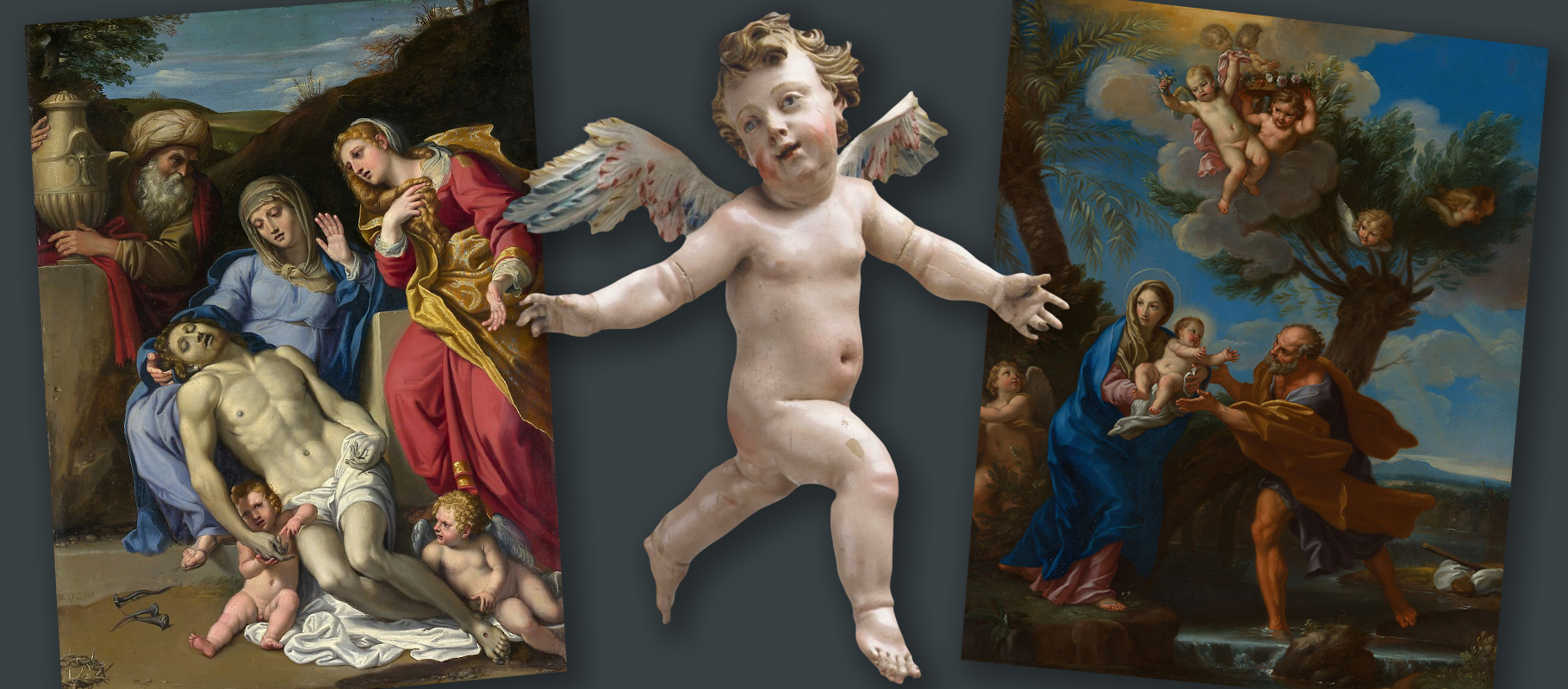 Above: cherubs at the feet of Christ in The Lamentation by Domenichino from 1603, a winged chuerb sculpture from the 18th-19th century, and cherubs above the holy family in The Flight into Egypt by Carlo Maratti, 1664
Above: cherubs at the feet of Christ in The Lamentation by Domenichino from 1603, a winged chuerb sculpture from the 18th-19th century, and cherubs above the holy family in The Flight into Egypt by Carlo Maratti, 1664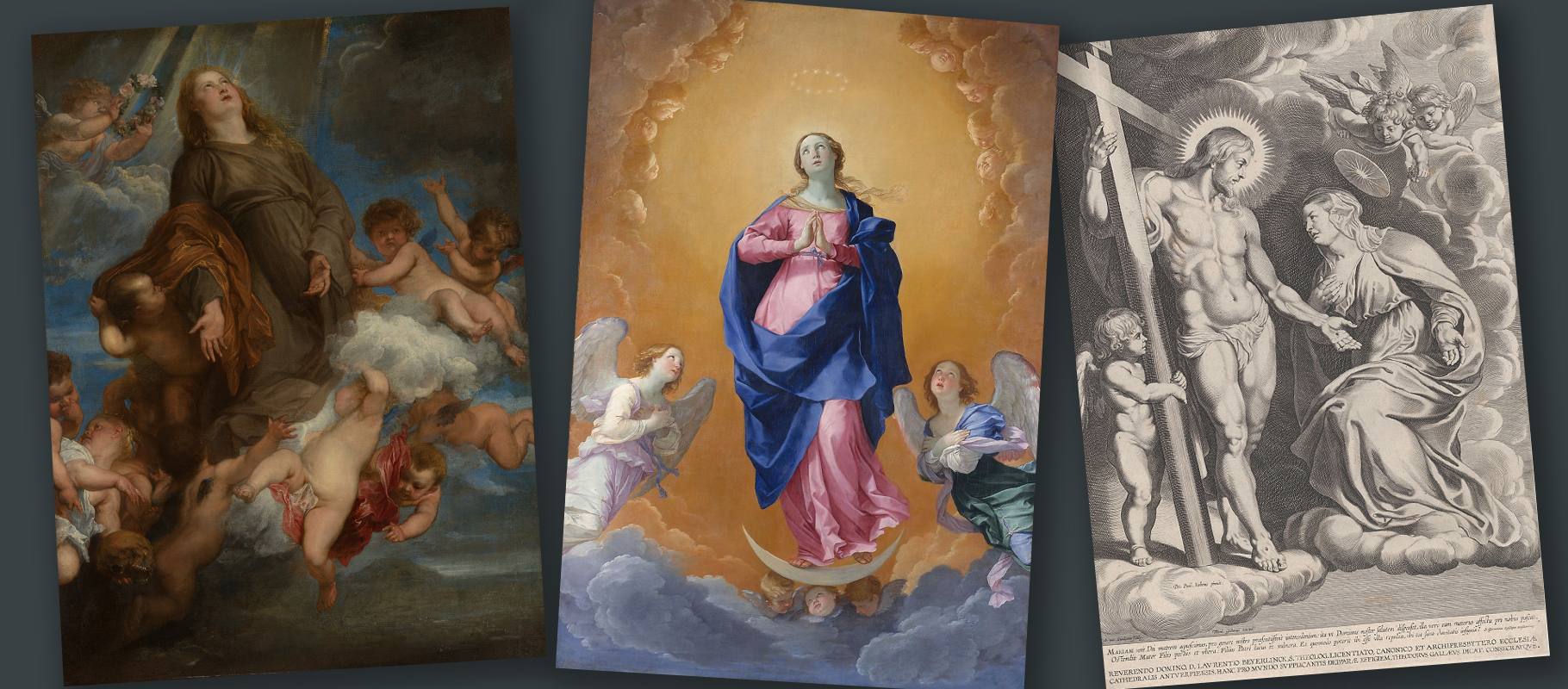 Above: Saint Rosalie Interceding for the Plague-stricken of Palermo by Anthony van Dyck from 1624, The Immaculate Conception by Guido Reni from 1627 and The Intercession of the Virgin after Rubens from 1610-37
Above: Saint Rosalie Interceding for the Plague-stricken of Palermo by Anthony van Dyck from 1624, The Immaculate Conception by Guido Reni from 1627 and The Intercession of the Virgin after Rubens from 1610-37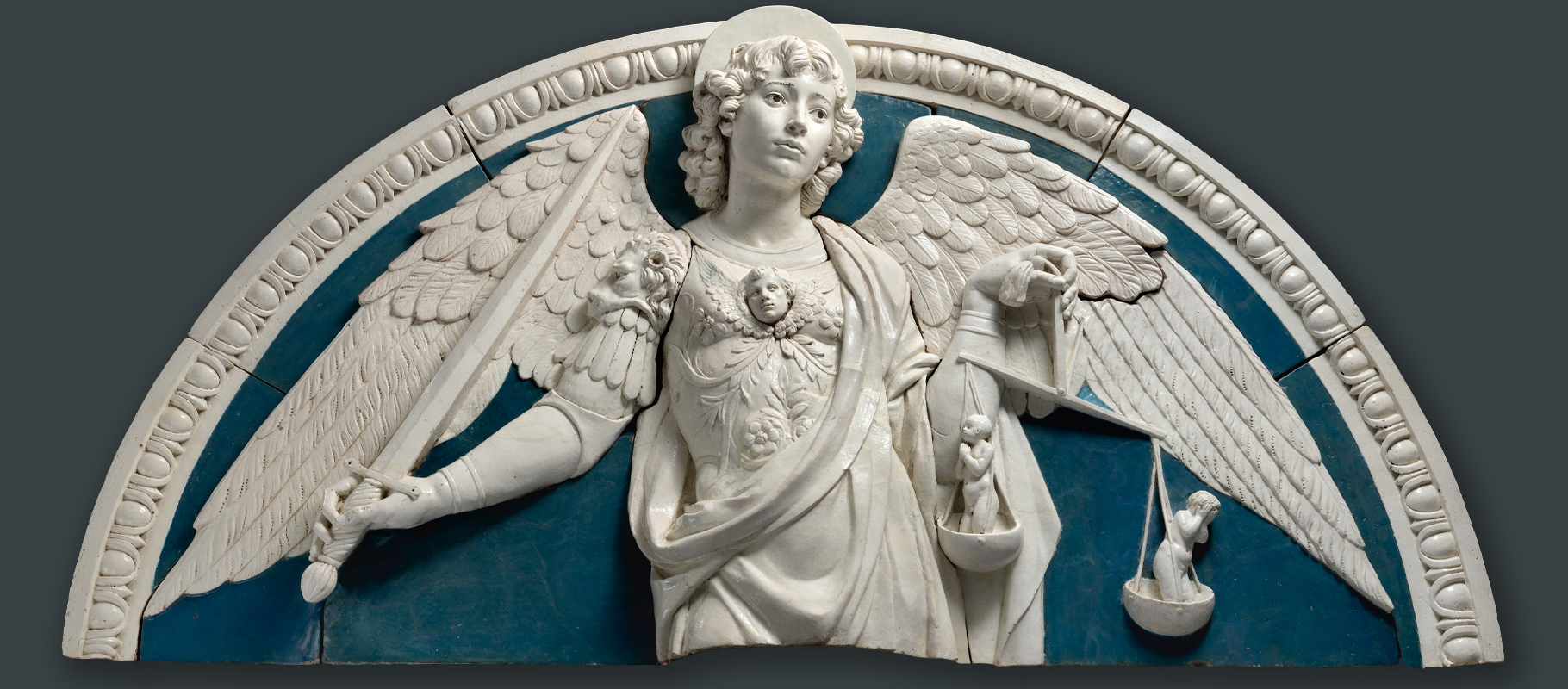 Above: glazed terracotta relief of Saint Michael the Archangel by Andrea della Robbia, 1475
Above: glazed terracotta relief of Saint Michael the Archangel by Andrea della Robbia, 1475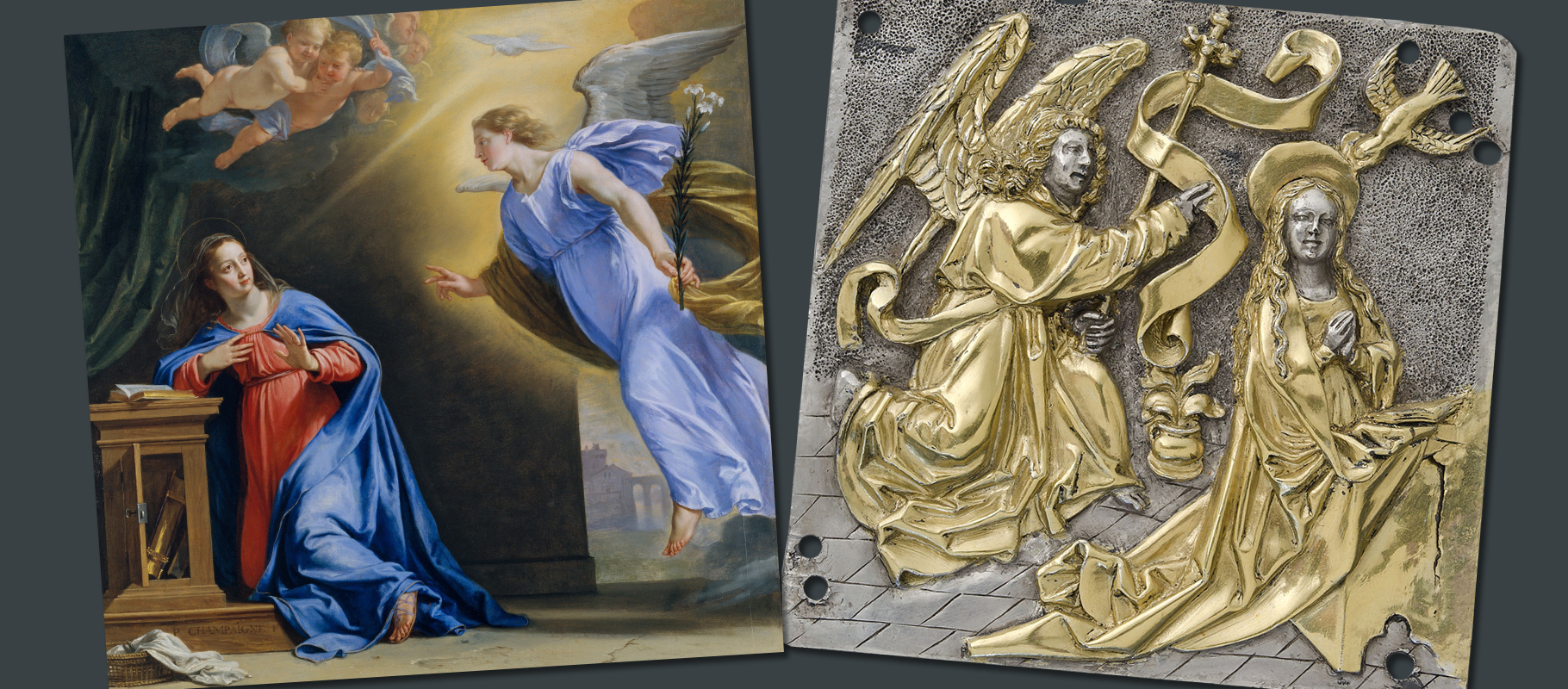 Above: The Annunciation by Philippe de Champaigne from 1644 and a gold and silver german plaque from the 15th century
Above: The Annunciation by Philippe de Champaigne from 1644 and a gold and silver german plaque from the 15th century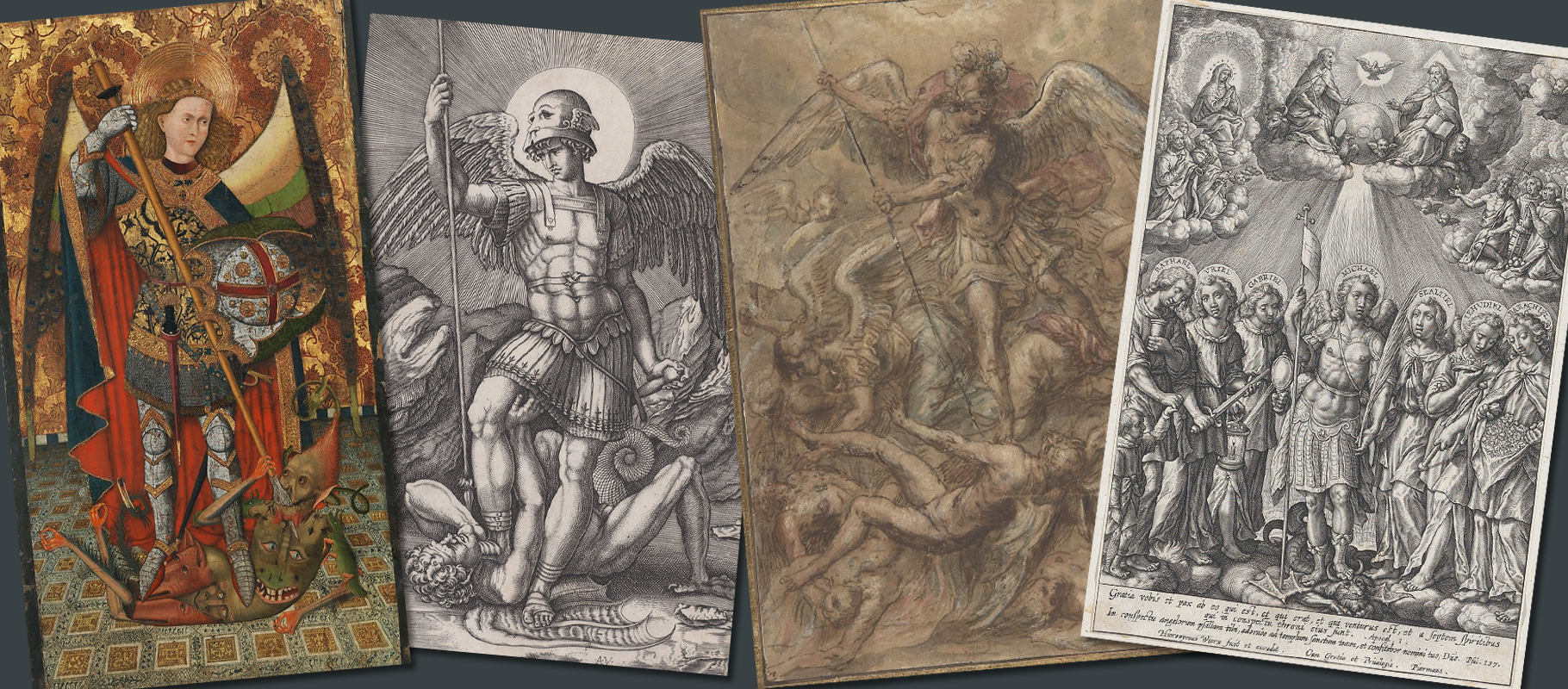 Above: Saint Michael by Master of Belmonte from 1450-1500, an engraving of Saint Michael after Raphael from 1514-16, Saint Michael Expelling the Fallen Angels from the 16th century and an enragving of The Seven Archangels by Hieronymus Wierix, 1570-1619
Above: Saint Michael by Master of Belmonte from 1450-1500, an engraving of Saint Michael after Raphael from 1514-16, Saint Michael Expelling the Fallen Angels from the 16th century and an enragving of The Seven Archangels by Hieronymus Wierix, 1570-1619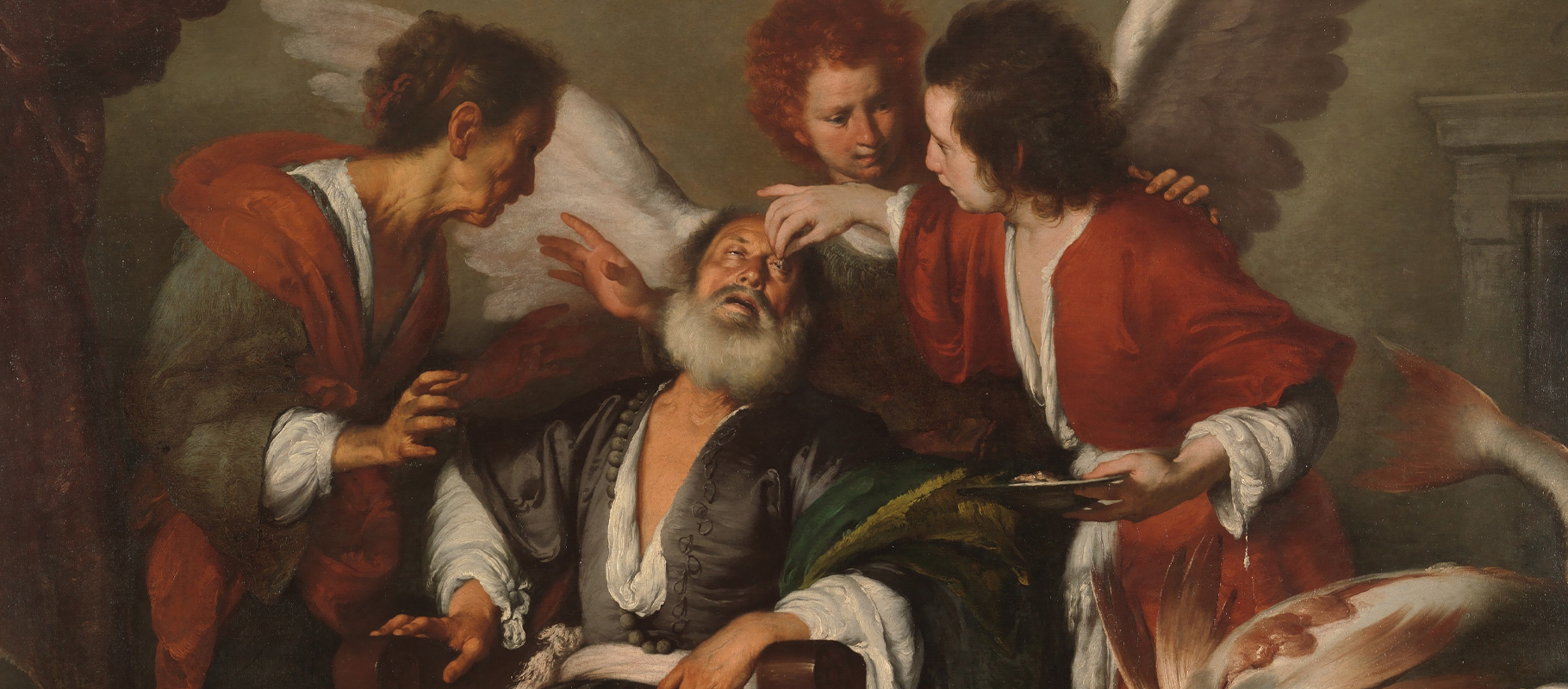 Above: a detail from Tobias Curing His Father’s Blindness by Bernardo Strozzi from 1630-35, featuring the archangel Raphael
Above: a detail from Tobias Curing His Father’s Blindness by Bernardo Strozzi from 1630-35, featuring the archangel Raphael  Above: a ceiling mural halfway through conservation by our team
Above: a ceiling mural halfway through conservation by our team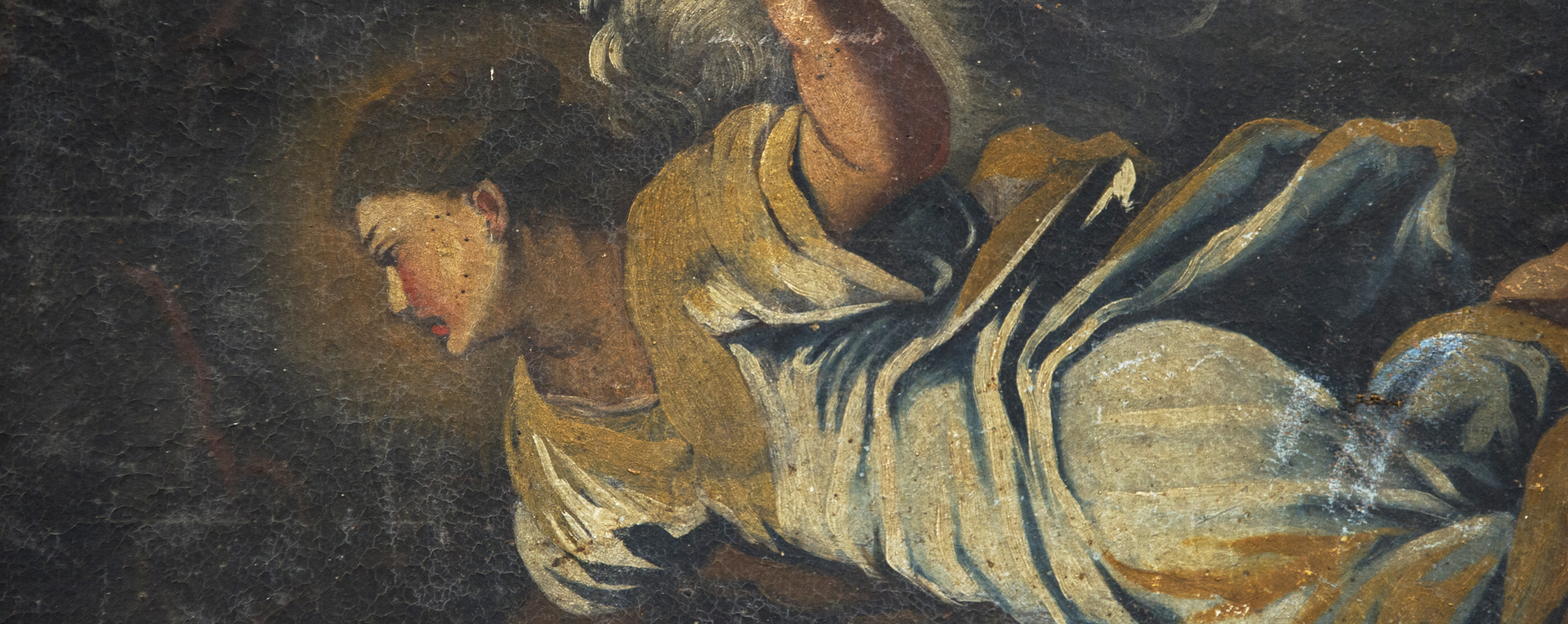 Above: a painting of an angel, before conservation work in our studio
Above: a painting of an angel, before conservation work in our studio




